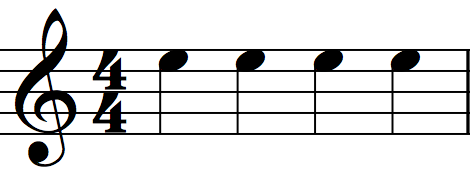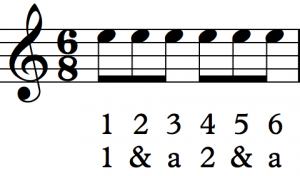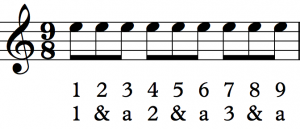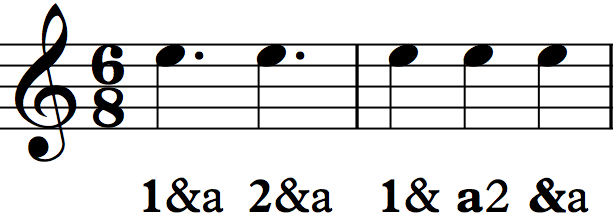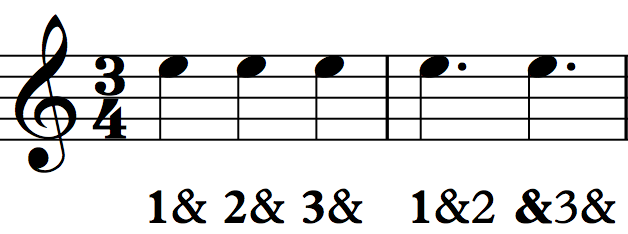9 Simple vs. Compound Meter
INTRODUCTION
In this unit you will learn simple and compound meters. You will also begin to sight-read compositions created especially for this series!
NOTATIONS
Simple vs. Compound Meter Explained
In Unit 2 you learned to describe meter in terms of how a measure is broken down into beats. Duple meter is broken into two beats per measure; triple meter into three beats per measure; and quadruple meter into four beats per measure.
The terms introduced in this unit—simple and compound—describe how a beat is broken down into smaller subdivisions. Simply put, beats are typically subdivided (AKA broken down) into twos or threes. Meters that subdivide most of the beats into two equal parts are called simple meters; meters that subdivide most of the beats into three equal parts are called compound meters. This seemingly small distinction makes huge difference in feel. For me, music in simple meter feels angular, whereas music in compound meter feels round. Let’s explore this distinction further.
Both examples below consist of four beats per measure and are therefore in quadruple meter. However, the first one is in simple quadruple meter and the second is in compound quadruple meter.
Simple Meter Example
In simple meter most beats are broken into two equal parts. Notice how the eighth notes are beamed in groups of two to emphasize the subdivision of the beat.
Therefore, in simple meter, each beat is represented by a quarter note.
Compound Meter Example

In compound meter most beats are broken into three equal parts. Notice how the eighth notes are beamed in groups of three to emphasize the subdivision of the beat.
Therefore, in compound meter, each beat is represented by a dotted-quarter note.
Six Types of Standard Meter
Similarly, duple and triple meters can be expressed in simple and compound as well. Thus, there are six types of standard meter in Western music:
Simple Duple
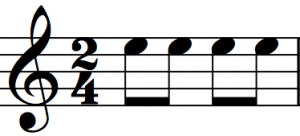
In simple duple meter most beats divide into eighth notes. There are two beats per measure and each beat is a quarter note.
Simple Triple
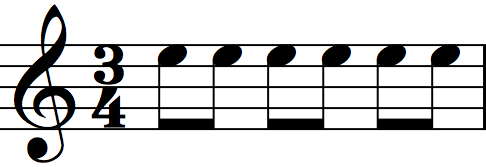
In simple triple meter most beats divide into eighth notes. There are three beats per measure and each beat is a quarter note.
Simple Quadruple
In simple quadruple meter most beats divide into eighth notes. There are four beats per measure and each beat is a quarter note.
Compound Duple
In compound duple meter most beats divide into three eighth notes. There are two beats per measure and each beat is equivalent to a dotted-quarter note. This meter can be counted in a variety of ways. The graphic above presents two options. I recommend using the second option because it emphasizes the duple feel.
Compound Triple
In compound triple meter most beats divide into three eighth notes. There are three beats per measure and each beat is equivalent to a dotted-quarter note. This meter can be counted in a variety of ways. The graphic above presents two options. I recommend using the second option because it emphasizes the triple feel.
Compound Quadruple
In compound quadruple meter most beats divide into three eighth notes. There are four beats per measure and each beat is equivalent to a dotted-quarter note. This meter can be counted in a variety of ways. The graphic above presents two options. I recommend using the second option because it emphasizes the quadruple feel.
The Hemiola
The hemiola is a device in which rhythmic accents switch from two beats subdivided in three parts to three beats subdivided in two parts (or vice versa). It creates excitement and energy. I suggest you emphasize the change in accent whenever you encounter a hemiola.
The Hemiola in Compound Meter
When a hemiola appears in compound meter the rhythmic accents switch from two beats subdivided in three parts to three beats subdivided in two parts.
The Hemiola in Simple Meter
When a hemiola appears in simple meter the rhythmic accents switch from three beats subdivided in two parts to two beats subdivided in three parts.
Simple vs. Compound Meter Time Signatures
Top Number of the Time Signature
To determine meter, you can employ the following short cut. Look to the top number of the time signature.
| Simple duple | 2 |
| Simple triple | 3 |
| Simple quadruple | 4 |
| Compound duple | 6 |
| Compound triple | 9 |
| Compound quadruple | 12 |
Bottom Number of the Time Signature
Simple Meter
As you learned in Unit 2, the bottom number of the time signature, in simple meter, corresponds to the type of note that becomes a single beat (AKA pulse, in this case). Therefore, if the bottom number is ‘4,’ then each beat is represented by a quarter note. It’s pretty simple, which is why it is called simple meter.
Compound Meter
In compound meter, the bottom number of the time signature corresponds to the type of note that becomes a one-third division of the beat (AKA pulse, in this case). If compound meter is notated such that the dotted-quarter note is the beat (as in the examples above) then the eighth note is the one-third division of the dotted-quarter. Hence, the number ‘8’ takes the place of the bottom number of the time signature.
Let’s Play |
Sight-Reading Tip
Sight-reading empowers you to engage with music you may have never heard before. Many musicians derive oodles of joy from bringing music notation to life for the first hearing. It is like unwrapping a present! Further, sight-reading creates an opportunity to decide whether a piece is worth investing the time needed to make it performance-ready.
When I started sight-reading for the purpose of scouting new performance repertoire, I finally stopped confusing the act of sight-reading with the act of performing. When I sight-read, my goal is to get a sense of the shape, character and difficulties of a piece. Sometimes, mistakes do not get in the way of achieving that goal, which is why they can be ignored. However, when I prepare for performance, my goal is to master the shape, character and difficulties of a piece. In this case, mistakes are crucial to goal attainment. Mistakes are obstacles that, when overcome, clear the path to greater mastery.
I want you to experience the difference between a sight-reading attitude and a performance-preparation attitude. This was one of my motivations for commissioning composers to write over thirty original duet compositions for this series. You do not have to perfect these compositions. All you have to do is sight-read them. If you don’t like the piece, feel free to continue through the series without mastering it. However, if you do like one or more of the compositions, I encourage you to shift from a sight-reading attitude to a performance-preparation attitude so you can add them to your performance repertoire. The original compositions are available in the Appendix as a collection entitled The Obelisks.
Checklist for Sight-Reading
- Count the beats out loud (including the &).
- Keep going (even if you make a mistake).
- Maintain your best playing posture.
- Look at the score, not your hands.
- Play with the feel of the meter.
- Play patterns instead of individual notes (AKA chunk).
- Cultivate a calm demeanor.
- Have fun!
Let’s Play Rhythms |
Attitude Tip
The most beautiful thing we can experience is the mysterious. It is the source of all true art and science. –Albert Einstein
Throughout this unit the count-in click for pieces in compound meter will include the eighth note subdivision of each beat. An emphasis will be placed on the beginning of each beat to help establish the compound meter feel .
Exercise 9.1: Score
Exercise 9.1: Audio
Exercise 9.2: Score
Exercise 9.2: Audio
Exercise 9.3: Score
Exercise 9.3: Audio
Let’s Play Patterns |
Attitude Tip
I have no special talents, I am only passionately curious. –Albert Einstein
Exercise 9.4: Score
Exercise 9.4: Audio
Let’s Play Duets |
Attitude Tip
The cure for boredom is curiosity. There is no cure for curiosity. –Dorothy Parker
from Sumer is Icumen In: Score
from Sumer is Icumen In: Audio
from Have a Drink on Me: Score
from Have a Drink on Me: Audio
Gigue from Partita in A Minor by Johann Anton Logy: Score
Gigue: Audio
The Obelisks
The compositions composed for this series are complied into a collection called The Obelisks. The collection is available for viewing and downloading in the Appendix (forthcoming). I hope you are inspired to perform these pieces and learn about the composers who contributed to this series.
Let’s Play Compositions |
These compositions are under the Creative Commons Attribution-NonCommercial 4.0 International License (CC BY-NC 4.0).
Attitude Tip
Curiosity is the engine of achievement. –Sir Ken Robinson
The First Time Alone by John Baboukis: Score
The First Time Alone: Audio
Before, No. 1 from Brief Moments by Mark Popeney: Score
Before, No. 1 from Brief Moments: Audio
Congratulations!
You have completed this unit! If you kept up with the beat and accurately played approximately 70% of the pitches and rhythms, you are ready for the next unit. Feel free to repeat the exercises. However, do not play them so often that you memorize them. Once you memorize the notation, you are no longer developing the skill of sight-reading.


